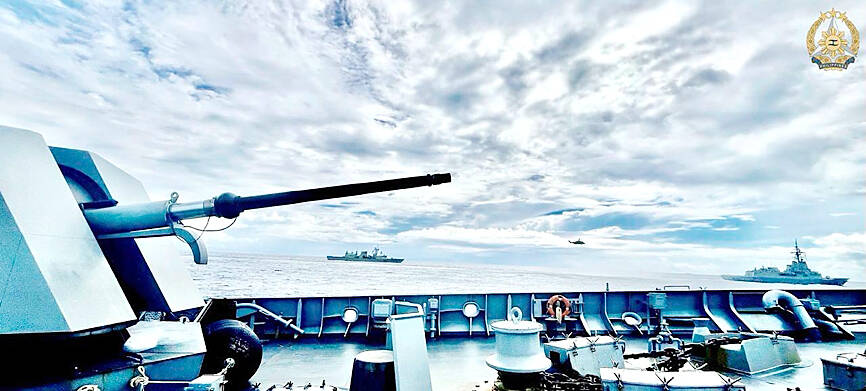Diners greedily crack open delicate rabbit skulls and slurp down their contents, tucking into a delicacy so popular in one province that it has to import its supplies from France.
Sichuan is renowned for its spicy, peppery local dishes: one of its favorites are rabbit brains, often eaten as a late night treat on the streets of its capital, Chengdu.
At the Shuangliu Laoma Tutou, a well-known restaurant in the heart of the city, dozens of customers use their gloved hands to prise open the skulls covered in sauce, suck out the brain and nibble on the cheeks amid cries of satisfaction.
“If Sichuanese people don’t eat spicy dishes every day, they’re unhappy,” said one woman surnamed Ma, as she dined with friends.
“I eat them at least once a week,” she added.
Westerners often avoid animal parts — duck beaks, chicken feet, heads and tripe — that Chinese gourmets treat as delicacies.
However, even in China there is little appetite for rabbits’ meat, much less their heads, which are overwhelmingly eaten in Sichuan, a remote province long isolated by mountain ranges.
The dish is a specialty of the region — rarely found outside of a few popular restaurants in Beijing and other major cities.
“Two out of three rabbit heads consumed in China, are eaten in Sichuan,” said Wang Min, the manager of the Chengdu restaurant, adding that locals were proud of the snack.
“My parents and grandparents ate them. I’ve been enjoying them since my childhood,” she said, adding the tradition goes back several centuries.
“My friends in Guangxi and elsewhere don’t understand why we eat them,” she said, adding “they can’t stand the pepper.”
In Wang’s restaurant, head chef Yin Ding-jun said the rabbit head recipe seemed simple, but required a well-established technique.
“You have to drain the rabbits of their blood, then remove the guts before marinating the head in a broth for several hours,” he said. “Diners then use their teeth to gnaw at the flesh.”
Rabbits feature in Chinese mythology — a jade rabbit lives on the moon — and are regarded as cute by many young people rather than thought of as a delicacy, although in Sichuanese dialect eating rabbit head is slang for French kissing.
Although sucking on a rabbit head might seem odd to some diners even in China, it is par for the course in Sichuanese cuisine, Fuchsia Dunlop, a London-based expert in Chinese gastronomy said.
“There are lots of spicy dishes, such as spicy duck heads, covered in chili and pepper,” she said.
For people in Sichuan, playing with your food is part of the fun, she said, adding they like “the grapple factor.”
“Using your fingers and teeth to get a little bit of meat, it’s part of the pleasure,” she said.
As night falls in Chendgu, innumerable stalls sell rabbit heads to locals who wash the treat down with beer.
“Night markets are part of our culture in Sichuan,” said Rong Li-peng, deputy chairman of Hage, China’s leading supplier of rabbit meat and products.
He sells more than 8 million rabbit heads each year, but faced with a colossal local demand Chinese farms are struggling to supply enough.
As a result, nearly 20 percent of rabbit heads marketed by the company are imported from Europe, mainly from Italy and France, and mostly frozen.
France exported 166 tonnes of meat and edible offal from rabbits to China in 2014, according to French government figures.
Hage, who said the heads are healthy since they contain little flesh, has now agreed to a partnership with French firm Hycole to provide breeding rabbits to its farms in China, the French company’s manager Fabien Coisne said.
He hopes that the taste for the treat will one day expand beyond Sichuan, but, he admits, the barrier is high.
“A lot of people outside our province do not dare taste them, because the rabbit heads do look quite terrifying,” he said.

Australia has announced an agreement with the tiny Pacific nation Nauru enabling it to send hundreds of immigrants to the barren island. The deal affects more than 220 immigrants in Australia, including some convicted of serious crimes. Australian Minister of Home Affairs Tony Burke signed the memorandum of understanding on a visit to Nauru, the government said in a statement on Friday. “It contains undertakings for the proper treatment and long-term residence of people who have no legal right to stay in Australia, to be received in Nauru,” it said. “Australia will provide funding to underpin this arrangement and support Nauru’s long-term economic

‘NEO-NAZIS’: A minister described the rally as ‘spreading hate’ and ‘dividing our communities,’ adding that it had been organized and promoted by far-right groups Thousands of Australians joined anti-immigration rallies across the country yesterday that the center-left government condemned, saying they sought to spread hate and were linked to neo-Nazis. “March for Australia” rallies against immigration were held in Sydney, and other state capitals and regional centers, according to the group’s Web site. “Mass migration has torn at the bonds that held our communities together,” the Web site said. The group posted on X on Saturday that the rallies aimed to do “what the mainstream politicians never have the courage to do: demand an end to mass immigration.” The group also said it was concerned about culture,

ANGER: Unrest worsened after a taxi driver was killed by a police vehicle on Thursday, as protesters set alight government buildings across the nation Protests worsened overnight across major cities of Indonesia, far beyond the capital, Jakarta, as demonstrators defied Indonesian President Prabowo Subianto’s call for calm. The most serious unrest was seen in the eastern city of Makassar, while protests also unfolded in Bandung, Surabaya, Solo and Yogyakarta. By yesterday morning, crowds had dispersed in Jakarta. Troops patrolled the streets with tactical vehicles and helped civilians clear trash, although smoke was still rising in various protest sites. Three people died and five were injured in Makassar when protesters set fire to the regional parliament building during a plenary session on Friday evening, according to

STILL AFLOAT: Satellite images show that a Chinese ship damaged in a collision earlier this month was under repair on Hainan, but Beijing has not commented on the incident Australia, Canada and the Philippines on Wednesday deployed three warships and aircraft for drills against simulated aerial threats off a disputed South China Sea shoal where Chinese forces have used risky maneuvers to try to drive away Manila’s aircraft and ships. The Philippine military said the naval drills east of Scarborough Shoal (Huangyan Island, 黃岩島) were concluded safely, and it did not mention any encounter with China’s coast guard, navy or suspected militia ships, which have been closely guarding the uninhabited fishing atoll off northwestern Philippines for years. Chinese officials did not immediately issue any comment on the naval drills, but they